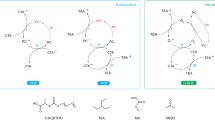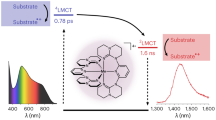Abstract
The photosensitized oxygenation of organic molecules plays a key role in numerous processes of biological and industrial significance, such as, for example, photodynamic action and photodegradation of polymers. These reactions proceed either via quenching by the substrate of photophysically generated singlet oxygen, O2(1Δg), or via addition of ground state oxygen to photochemically generated radicals derived from the substrate, or via both pathways. The evaluation of the contributions of both mechanisms to the overall process requires reference sensitizers that exclusively induce one of the corresponding reactions. Some compounds are known to produce singlet oxygen with unit efficiency, but no references to sensitizers producing free radicals but no singlet oxygen have been found so far. In this work, we propose to use the decatungstate anion, W10O324-, as a first reference sensitizer for free radical oxygenations of organic molecules. A combination of time-resolved and steady-state studies has been performed to compare the photo-oxygenation of simple reference compounds, including 2-methyl-2-pentene and 2,3-dimethylbutene, by W10O324- and by classical O2(1Δg) sensitizers, such as methylene blue and ruthenium complexes. It is demonstrated that W10O324- sensitized oxygenation of organic compounds occurs exclusively by a free radical pathway, which differs clearly from both Type I and Type II oxygenations. Comparison with Type II reactions shows that: (i) in spite of their weaker reactivity, singlet oxygen mediated reactions are associated with larger photo-oxygenation yields than W10O324- induced processes, due to the longer lifetime of the reactive species; and (ii) reaction of alkenes with both singlet oxygen and decatungstate features charge transfer interactions, whose magnitude is larger in the case of O2(1Δg).
Similar content being viewed by others
References
G. O. Schenck, Photosensitization, Ind. Eng. Chem., 1963, 55, 40–43.
G. O. Schenck and E. Koch, Zwischenreaktionen bei photosensibilisierten Prozessen in Lösungen, Z. Elektrochem., 1960, 64, 170–177.
K. Gollnick, Type II photooxygenation reactions in solution, Adv. Photochem., 1968, 6, 1–122.
C. S. Foote, Mechanisms of photosensitized oxidation, Science, 1968, 162, 963–970.
C. S. Foote, Photosensitized oxidation and singlet oxygen: Consequences in biological systems, in Free Radicals in Biology 2, ed. W. A. Pryor, Academic Press, New York, 1976, pp. 85–133.
C. S. Foote, Type I and Type II mechanisms in photodynamic action. In light-activated pesticides, in ACS Symposium Ser. 339, ed. J. R. Heitz and K. R. Downum, American Chemical Society, 1987, Washington D.C., pp. 22–38.
C. S. Foote, Chemical mechanisms of photodynamic action, in Future Directions and Applications in Photodynamic Therapy, Spie Institute Series, Optical Engineering Press, Bellingham, WA, 1990, vol. IS6, pp. 115–126.
C. Tanielian, Photooxygénations sensibilisées par les colorants, Biochimie, 1986, 68, 797–806.
C. Tanielian, R. Mechin, R. Seghrouchni and C. Schweitzer, Mechanistic and kinetic aspects of photosensitization in the presence of oxygen, Photochem. Photobiol., 2000, 71, 12–19.
R. Schmidt, C. Tanielian, R. Dunsbach and C. Wolff, Phenalenone, a universal reference compound for the determination of quantum yields of singlet oxygen O2(1Δg) sensitization, J. Photochem. Photobiol., A, 1994, 79, 11–17.
C. Tanielian, Decatungstate photocatalysis, Coord. Chem. Rev., 1998, 180, 1165–1181.
D. C. Duncan, T. L. Netzel and C. L. Hill, Early-time dynamics and reactivity of polyoxometalate excited states. Identification of a short-lived LMCT excited state and a reactive long-lived charge-transfer intermediate following picosecond flash excitation of W10O324- in acetonitrile, Inorg. Chem., 1995, 34, 4640–4646.
I. Texier, J. F. Delouis, J. A. Delaire, C. Giannotti, P. Plaza and M. M. Martin, Dynamics of the first excited state of the decatungstate anion studied by subpicosecond laser spectroscopy, Chem. Phys. Lett., 1999, 311, 139–145.
L. P. Ermolenko, C. Giannotti and J. A. Delaire, Laser flash photolysis study of the mechanism of photooxidation of alkanes catalyzed by decatungstate anion, J. Chem. Soc., Perkin Trans. 2, 1997, 25–30.
C. Tanielian, K. Duffy and A. Jones, Kinetic and mechanistic aspects of photocatalysis by polyoxotungstates: a laser flash photolysis, pulse radiolysis, and continuous photolysis study, J. Phys. Chem. B, 1997, 101, 4276–4282.
D. C. Duncan and M. A. Fox, Early events in decatungstate photocatalyzed oxidations: A nanosecond laser transient absorbance reinvestigation, J. Phys. Chem. A, 1998, 102, 4559–4567.
C. Tanielian, R. Seghrouchni and C. Schweitzer, Decatungstate photocatalyzed electron-transfer reactions of alkenes. Interception of the geminate radical ion pair by oxygen, J. Phys. Chem. A, 2003, 107 8, 1102–1111.
R. F. Renneke, M. Pasquali and C. L. Hill, Polyoxometalate systems for the catalytic selective production of nonthermodynamic alkenes from alkanes. Nature of excited-states deactivation processes and control of subsequent thermal processes in polyoxometalate photoredox chemistry, J. Am. Chem. Soc., 1990, 112, 6585–6594.
C. Tanielian and C. Wolff, Determination of the parameters controlling singlet oxygen production via oxygen and heavy-atom enhancement of triplet yields, J. Phys. Chem., 1995, 99, 9831–9837.
C. Tanielian and C. Wolff, Porphyrin-sensitized generation of singlet molecular oxygen: comparison of steady-state and time-resolved methods, J. Phys. Chem., 1995, 99, 9825–9830.
C. Tanielian and G. Heinrich, Effect of aggregation on the hematoporphyrin-sensitized production of singlet molecular oxygen, Photochem. Photobiol., 1995, 61, 131–135.
C. Tanielian, C. Wolff and M. Esch, Singlet oxygen production in water: Aggregation and charge-transfer effects, J. Phys. Chem., 1996, 100, 6555–6560.
R. D. Mair and A. Graupner, Determination of organic peroxides by iodine liberation procedures, Anal. Chem., 1964, 36, 194–204.
C. T. Timpson, C. C. Carter and J. Olmsted, III, Mechanism of quenching of electronically excited ruthenium complexes by oxygen, J. Phys. Chem., 1989, 93, 4116–4120.
Q. G. Mulazzani, H. Sun, M. Z. Hoffman, W. E. Ford and M. A. J. Rodgers, Quenching of the excited-states of ruthenium(II)-diimine complexes by oxygen, J. Phys. Chem., 1994, 98, 1145–1150.
A. Abdel-Shafi, P. D. Beer, R. J. Mortimer and F. Wilkinson, Photosensitized generation of singlet oxygen from (substituted bipyridine)ruthenium(II) complexes, Helv. Chim. Acta, 2001, 84, 2784–2795.
Z. Mehrdad, C. Schweitzer and R. Schmidt, Formation of O2(1Σg+), O2(1Δg) and O2(3Σg-) during oxygen quenching of nπ* triplet phenyl ketones: The role of charge transfer and sensitizer-oxygen complex structure, J. Phys. Chem. A., 2002, 106, 228–235.
C. Tanielian, L. Golder and C. Wolff, Production and quenching of singlet oxygen by the sensitizer in dye-sensitized photo-oxygenations, J. Photochem., 1984, 25, 117–125.
C. Tanielian R. Mechin, Quenching of singlet oxygen by methylene blue, Proceedings of the Xth IUPAC Symposium on Photochemistry, Presses polytechniques romandes, Lausanne, 1984, pp. 471–472.
C. Tanielian and L. Golder, Physical quenching of singlet oxygen by common reactive O21Δg Acceptor, Proceedings of the Xth IUPAC Symposium on Photochemistry, Presses polytechniques romandes, Lausanne, 1984, pp. 469–470.
C. Tanielian and R. Mechin, Interaction of singlet molecular oxygen with disubstituted olefins. Evidence for a physical quenching induced by the hydrocarbon chain, J. Phys. Chem., 1988, 92, 265–267.
M. A. J. Rodgers, Solvent-induced deactivation of singlet oxygen: Additivity relationships in nonaromatic solvents, J. Am. Chem. Soc., 1983, 105, 6201–6205.
R. Schmidt and E. Afshari, Collisional deactivation of O2(1Δg) by solvent molecules. Comparative experiments with 16O2 and 18O2, Ber. Bunsen-Ges. Phys. Chem., 1992, 96, 788–794.
C. Schweitzer, Z. Mehrdad, F. Shafii and R. Schmidt, Common Marcus type dependence of the charge transfer induced processes in the sensitization and quenching of singlet oxygen by naphthalene derivatives, J. Phys. Chem. A., 2001, 105, 5309–5316.
C. Schweitzer, Z. Mehrdad, F. Shafii and R. Schmidt, Charge transfer induced quenching of triplet sensitizers by ground state oxygen and of singlet oxygen by ground state sensitizers: A common deactivation channel, Phys. Chem. Chem. Phys., 2001, 3, 3095–3101.
C. Schweitzer, Z. Mehrdad, A. Noll, E.-W. Grabner and R. Schmidt, Oxygen quenching of nπ* triplet phenyl ketones: Local excitation and local deactivation, Helv. Chim. Acta, 2001, 84, 2493–2507.
C. S. Foote and S. Wexler, Singlet oxygen. A probable intermediate in photosensitized autoxidations, J. Am. Chem. Soc., 1964, 86, 3879–3880.
A. Molinari, R. Amadelli, A. Mazzacani, G. Sartori and A. Maldotti, Tetralkylammonium and sodium decatungstate heterogenized on silica: effects of the nature of cations on the photocatalytic oxidation of organic substrates, Langmuir, 2002, 18, 5400–5405.
O. L. J. Gijzeman, F. Kaufman and G. Porter, Oxygen quenching of aromatic triplet states in solution, J. Chem. Soc., Faraday Trans. 2, 1973, 69, 708–720.
R. Schmidt, F. Shafii, C. Schweitzer, A. A. Abdel-Shafi and F. Wilkinson, Charge transfer and non-charge transfer processes competing in the sensitization of singlet oxygen: Formation of O2(1Σg+), O2(1Δg) and O2(3Σg-) during oxygen quenching of triplet excited naphthalene derivatives, J. Phys. Chem. A., 2001, 105, 1811–1817.
C. Schweitzer, Z. Mehrdad, A. Noll, E.-W. Grabner and R. Schmidt, The mechanism of photosensitized generation of singlet oxygen during oxygen quenching of triplet states and the general dependence of the rate constants and efficiencies of O2(1Σg+), O2(1Δg) and O2(3Σg-) formation on sensitizer triplet state energy and oxidation potential, J. Phys. Chem. A, submitted for publication.
D. J. McGarvey, P. G. Szekeres and F. Wilkinson, The efficiency of singlet oxygen generation by substituted naphthalenes in benzene. Evidence for participation of charge-transfer interactions, Chem. Phys. Lett., 1992, 199, 314–319.
A. P. Darmanyan, W. Lee and W. S. Jenks, Charge transfer interactions in the generation of singlet oxygen O2(1Δg) by strong electron donors, J. Phys. Chem. A, 1999, 103, 2705–2711.
F. Wilkinson and A. A. Abdel-Shafi, Mechanism of quenching of triplet states by molecular oxygen: Biphenyl derivatives in acetonitrile, J. Phys. Chem. A, 1997, 101, 5509–5516.
F. Wilkinson and A. A. Abdel-Shafi, Mechanism of quenching of triplet states by molecular oxygen: Biphenyl derivatives in different solvents, J. Phys. Chem. A, 1999, 103, 5425–5435.
C. Tanielian, M. Kobayashi and C. Wolff, Mechanism of photodynamic activity of pheophorbides, J. Biomed. Opt., 2001, 6, 252–256.
C. Tanielian, C. Schweitzer, R. Mechin and C. Wolff, Quantum yield of singlet oxygen production by monomeric and aggregated forms of hematoporphyrin derivative, Free Radical Biol. Med., 2001, 30, 208–212.
M. V. Encinas and J. C. Scaiano, Reaction of benzophenone triplets with allylic hydrogens. A laser flash photolysis study, J. Am. Chem. Soc., 1981, 103, 6393–6397.
A. P. Darmanyan, W. S. Jenks and P. Jardon, Charge-transfer quenching of singlet oxygen O2(1Δg) by amines and aromatic hydrocarbons, J. Phys. Chem. A., 1998, 102, 7420–7426.
C. Tanielian and C. Wolff, Mechanism of physical quenching of singlet molecular oxygen by chlorophylls and related copmounds of biological interest, Photochem. Photobiol., 1988, 48, 277–280.
F. P. Lossing and J. C. Traeger, Stabilization in cyclopentadienyl, cyclopentenyl, and cyclopentyl cations, J. Am. Chem. Soc., 1975, 97, 1579–1580.
J. C. Scaiano, Intermolecular photoreductions of ketones, J. Photochem. 2, 1973/1974, 81–118.
P. J. Wagner, Chemistry of excited triplet organic carbonyl compounds, Top. Curr. Chem., 1976, 66, 1–51.
N. E. Schore and N. J. Turro, Mechanism of the interaction of n,π* excited alkanones with electron-rich ethylenes, J. Am. Chem. Soc., 1975, 97, 2482–2488.
I. E. Kochevar and P. J. Wagner, Quenching of triplet phenyl ketones by olefins, J. Am. Chem. Soc., 1972, 94, 3859–3865.
R. O. Loutfy, S. K. Dogra and R. W. Yip, The interaction between the excited triplet state of ketones and olefins: the role of triplet exciplexes, Can. J. Chem., 1979, 57, 342–347.
K. Gollnick, Oxygen and Oxy-radicals in Chemistry and Biology, On the mechanism of the ene-reactions with singlet oxygen O2(1Δg): dependance of rates on solvent polarity and structure, Oxygen and oxy-radicals in chemistry and biology, ed. M. A. J. Rodgers and E. L. Powers, Academic Press, New York, 1981, pp. 379–395.
M. Stratakis, M. Orfanopoulos, Regioselectivity in the ene reaction of singlet oxygen with alkenes, Tetrahedron, 2000, 56, 1595–1615.
A. A. Gorman, The bimolecular reactivity of singlet molecular oxygen, Adv. Photochem., 1992, 17, 217–274.
Author information
Authors and Affiliations
Additional information
Dedicated to Professor Jean Kossanyi on the occasion of his 70th birthday.
Rights and permissions
About this article
Cite this article
Tanielian, C., Schweitzer, C., Seghrouchni, R. et al. Polyoxometalate sensitization in mechanistic studies of photochemical reactions: The decatungstate anion as a reference sensitizer for photoinduced free radical oxygenations of organic compounds. Photochem Photobiol Sci 2, 297–305 (2003). https://doi.org/10.1039/b210786b
Received:
Accepted:
Published:
Issue Date:
DOI: https://doi.org/10.1039/b210786b




